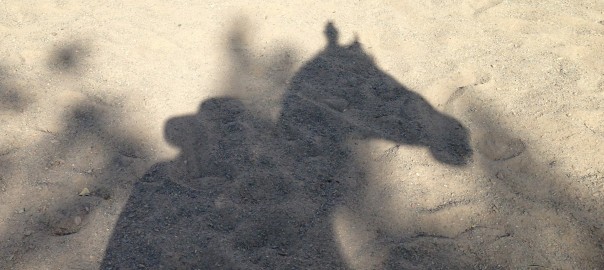It’s a rainy day as I write this. A rainy day in New Mexico is generally cause for celebration. The state squeaks out 13.85 inches average rainfall per year.
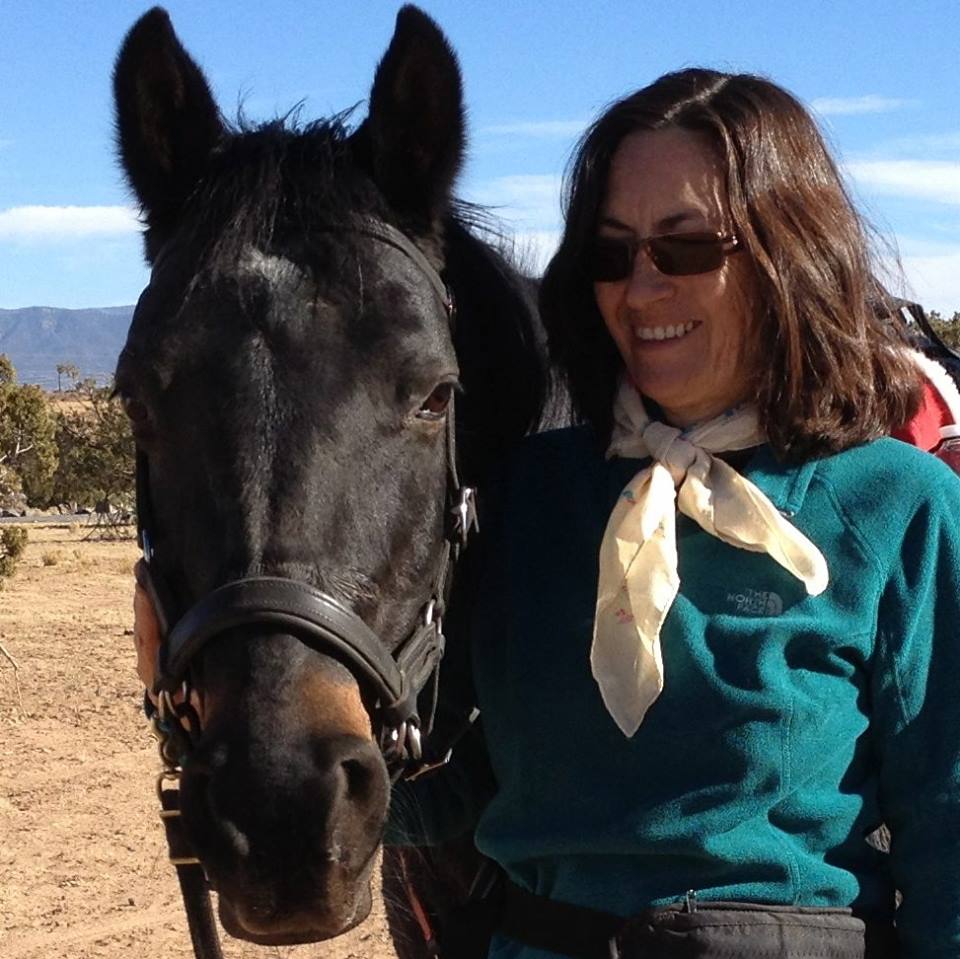

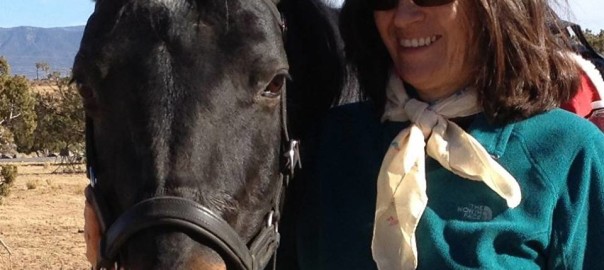
It’s a rainy day as I write this. A rainy day in New Mexico is generally cause for celebration. The state squeaks out 13.85 inches average rainfall per year.

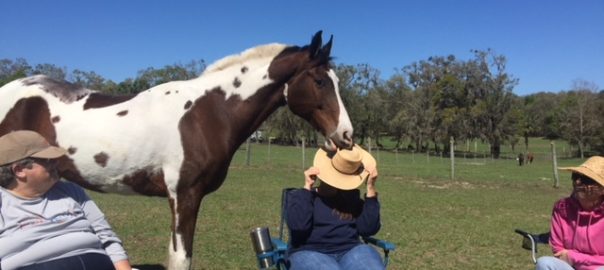
In Buddhism there is the Tibetan word “Shenpa,” that can be translated “something that hooks us,” according to Buddhist teacher Pema Chodron. It is also “the urge.”
Shenpa is what drives habitual patterns, motives and addictions. It comes in two parts: the reaction to pain and the escaping of pain. And the reaction to an insult, or something you don’t like that someone has said or done.
While it can be easily seen in overeating, binge drinking and attachment to anger, it can also be seen in overdoing and attachment to good things, like meditation or doing good for the world.
As people, we want things to remain the same. We live in a changing world that fills us with insecurity. If we experience one wonderful experience, we want all experiences with that one person or animal to continue to be that wonderful.
This is where horses come in. Horses don’t come to us seeking for us to do trot circles or train them to become Grand Prix competitors. They would be perfectly happy with space, grass, shelter, water and friends. As long as they have these things, their needs are met. They don’t generally think the way we do in this way.
So, when we come in with an agenda, we override their natural flow. But what if we drop that agenda and just hang out for a while, as though we are visiting herd members, and see what happens?
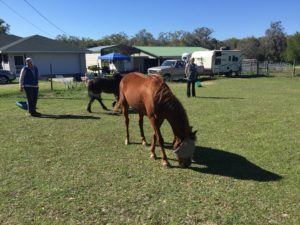 We worked with this concept in the Florida workshop this past weekend. A wide variety of equines made it possible to see how they interacted with people.
We worked with this concept in the Florida workshop this past weekend. A wide variety of equines made it possible to see how they interacted with people.
Cocoa the pony has been to the workshops before, and generally, he is a self-confident, proud pony who does his job pulling a cart very well. He doesn’t interact much with the people because he likes things the way they are. I noticed he was very good at doing what I asked, but that there wasn’t any engagement between us. Over the years of working with Cocoa, he has become more personable with his owner.
So, I stopped doing anything and I turned away from him. Within minutes he came over to me to visit and breathe with me.
Another time I was just walking behind him and I felt him moving far ahead of me, and sensed that he thought I was chasing him, even though I did not feel I was at all. It was his perception. I stopped again. Other people also had that experience with him. (The pony mare Amber demonstrated how to move Cocoa very effectively).
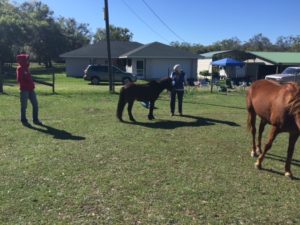 In Liberty Foundations, we want to be accepted by the herd but change our position in the herd organically. But sometimes our Shenpa gets in the way and we keep on asking, seeking a particular outcome.
In Liberty Foundations, we want to be accepted by the herd but change our position in the herd organically. But sometimes our Shenpa gets in the way and we keep on asking, seeking a particular outcome.
Another gelding, Jack, didn’t want to be separated from his mares who were in heat in the next pasture. There were other visiting geldings so he needed to ensure his herd was safe. So we worked around that, and actually he began to enjoy dancing and running with his owner Anne, even taking her cue to go into the beginnings of a Spanish walk, which he’d never done before. She was naturally very excited by this.
The next day Jack simply wouldn’t leave the fence, and got frustrated with anyone trying to engage with him. He had a few brief moments of going over cavaletti and engaging, but it was clear that he didn’t want to be with people. So we let him back in with his mares.
 He was a different horse the second day. It was a big lesson for all of us – we had our hopes high, we had seen Jack’s performance the day before and wondered what he could achieve the second day. He was full of such animation and joy that day, and the next, nada. We were hooked.
He was a different horse the second day. It was a big lesson for all of us – we had our hopes high, we had seen Jack’s performance the day before and wondered what he could achieve the second day. He was full of such animation and joy that day, and the next, nada. We were hooked.
It was as Pema Chodron said, we want all experiences with that one person or animal to continue to be that wonderful.
We are attached. At that point it was important to check our personal energy and drop it. I noticed when I worked with Jack that when I dropped my energy and with it, my desire to move him, have him begin elevating his feet in that dancy step, he could give more attention to me. If I offered him something, companionship at the gate, a tuft of hay, he had more interest. His attention was divided at best, because of the mares, but there was a glimpse of attention to me.
While the work is simple, we also encountered the edge of the horse’s tolerance. I like to stop working before we come to that, but sometimes the horse gets there first. Prince was excellent at working with numerous people and softening in his demeanor, coming away from food and into relationship. He wanted private time in the form of frequent pauses, and he feared being crowded. We could see that when our own urge to have him do more got in the way, he didn’t want to participate further. Shenpa.
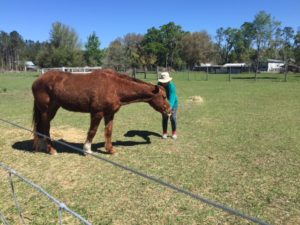 Cherokee is an older mare I have always felt was angry. She had a hard life before Anne took her in, and has also suffered a lot in her body. With a horse with this kind of anger, you want to stay clear of what she is carrying. Drop your energy into your feet, keep it light. She has her own Shenpa, a negative expectation. At the same time, she wants human attention.
Cherokee is an older mare I have always felt was angry. She had a hard life before Anne took her in, and has also suffered a lot in her body. With a horse with this kind of anger, you want to stay clear of what she is carrying. Drop your energy into your feet, keep it light. She has her own Shenpa, a negative expectation. At the same time, she wants human attention.
We chose an exercise that would engage her and please her at the same time. She became light and curious in her being, and the anger she arrived with dissipated.
It has taken awhile for Penny to come around to separating from her herd, but last year she made some big strides. This year, she was in heat and wasn’t happy leaving her herd. She could work well with her owner Gabi, and did quiet down with others also. When she engages, she is very soft and willing, but when she gets anxious, sometimes she doesn’t know you’re there.
We worked with separating horses who spend all their days together and reuniting them. We worked in short segments, extending their attention span, and coming up against a wall of resistance in others.
Not only do we have a different horse on a different day, we are also different. On some days, the horses graze close to one another, on other days they are far apart. The heart of the horse beats with the rhythm of the herd, a group heartbeat. Our challenge is to get our hearts to beat with it, dropping expectations, reshaping what we want from the horse. If we become a valid herd member, then the horse will be able to separate out from the herd more easily, and attention to us will increase.
(c) Susan Smith, Horses at Liberty Foundation Training, Equine Body Balance (TM)
See my
Events for information on upcoming clinics and workshops. 2018 calendar is developing! Workshops scheduled for Santa Fe,Wisconsin, Colorado, Oregon and Maryland!
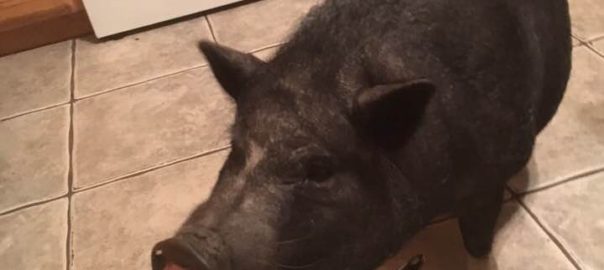
Years ago, I was teachnig in Florida at my friend Anne’s ranch, and her young pig Rosie got into my luggage. She ate face cream, my snack bars, and other stuff from my open suitcase. I caught her at it, and promptly guided her out, walking behind her, as I would with a horse.
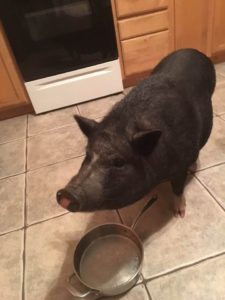
There was a a lot of squealing, turning to face me with upturned, indignant snout, but Rosie the Wrecking Ball did move off to other food sources.
At that time, I had not been around pigs much and had no idea if any of that liberty work would work on a pig, but it did. I think that was how she was trained from that day forward.
A friend who had grown up on a farm said if you could do Liberty Foundations with a chicken, then you could very easily do it with a horse. I’ve not had that experience, although a rooster did come to one of my workshops, tucked lovingly into the jacket of one of the attendees. We had so many horses to work with we didn’t have time to work with the rooster, but it’s on my bucket list!
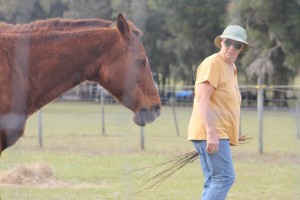
The point of all this is, we who practice Liberty Foundations or other alternative forms of horsemanship or training, are traveling a trail less traveled. If you can practice it with a chicken or a pig, you can do it with a horse. We are giving the horse an opportunity to choose. There are obviously times when we must ask the horse to do something they may not wish to do, like with Rosie, asking her to get out of my luggage. Or like our kids must brush their teeth, eat their vegetables, etc. but if they get a choice between certain things at some times, they feel their world open up. It also may be that brushing one’s teeth becomes less onerous because they know that they will get to do something fun afterwards. I used to take my kids to get ice cream after getting immunizations.
The ice cream is more of a reward system, but we have rewards built into liberty as well. Any approach where we are rewarding good behavior and not focusing on bad behavior will give great rewards in terms of connection, communication and lasting work together.
The trail less traveled may be filled with brambles. It may be a bushwhacking trail, where 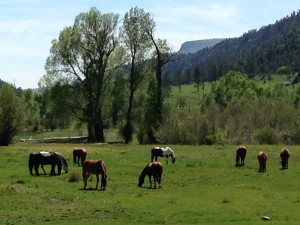 there isn’t a trail but in order not to fall off a cliff you are traversing the side of a mountain and carving out a path so you can ride down into a beautiful valley or other limitless vista. People who follow tried-and-true methods without exploring possible options won’t have this problem because their course is already set. They pick a place where there isn’t the possibility of lost trail, quicksand or other challenges. It’s challenging enough just to get the basics on the animal, let alone go off into the unknown.
there isn’t a trail but in order not to fall off a cliff you are traversing the side of a mountain and carving out a path so you can ride down into a beautiful valley or other limitless vista. People who follow tried-and-true methods without exploring possible options won’t have this problem because their course is already set. They pick a place where there isn’t the possibility of lost trail, quicksand or other challenges. It’s challenging enough just to get the basics on the animal, let alone go off into the unknown.
What if it’s like she said, the horse won’t respect me if I don’t get tough?
Well, I ask, what are your convictions? Do you feel okay about what’s happening or do you shrink from the tough work with your horse? Do you feel your point could be made with less force? Do you want an adversarial relationship with your horse because you can get the horse to submit that way?
My other question is, what is your energy like? Feel it in all its glorious dimensions. Is it forward, back, side-side, up-down, does it feel good in all those dimensions or is it missing out somewhere? Is it squishy or dark or inaccessible?
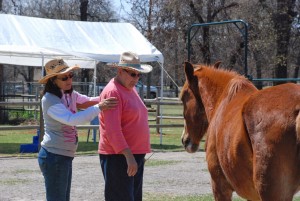
The horse will notice these things. The horse has a veritable PhD in energy. When people say you must work with intention, this energy and dimension stuff all fits into that one word. Your intention can be blocked by the energy in your dimensions without you knowing about it.
So it’s not just about the doing. It’s not about being so scary the horse absolutely has to do what you say. It’s how you are inside.
Many students become intimidated at this stage because they know the teacher has more knowledge than they do, so they better listen, even though their gut is twisting with angst. They feel their horse not want to be near them. While the horse does everything the student wants now, the student feels they have lost their horse.
Where is the fun-loving sweetness and eagerness? The student may try to win the horse back with lots of cookies or pets, but they are nervous and tipped over in the relationship now. Someone else is directing the flow even when the horse and owner are alone. Training by intimidation.
It’s difficult to hold onto your convictions if you know that someone knows more than you. But you have convictions. Think about other areas of your life where you feel very strongly about things: your chosen profession, animal rights, the environment, education, world peace, etc.
There is also the thing where the professional may say, well what you’re doing doesn’t work because you still haven’t accomplished what you set out to do.
My reply could be, yes, but I have a horse who has light in her eyes, who is still curious about our work together, who meets me at the gate. Whether we meet the goal is less important to me than the process.
In a way it’s like psychotherapy. When I was in therapy, the therapist would always say, it’s a process.
It’s a process, like health is also a process. When I work with horses and people, they become better hopefully, and sometimes they have setbacks or get injured and I see them more often. Sometimes I work with them near death. That’s life.
If I lose my horse’s trust, which has happened to me, I worry that I may not regain it. I have breached a confidence, some understanding we share. I have the greater intellect, so I am responsible for not abusing that. The horse has the greater primal intellect; he knows how to live in nature and by primal rules. His responsibility is to not take advantage of his position also, but may need to learn that in relationship with humans. This is where we offer guidance.
If I demonstrate enough trustworthy behavior I can generally regain the confidence and trust of my horse, unless the horse has been abused a great deal before I came along. But at that point I must continue to offer a good deal, and if I have to ask more of my horse than he wants to do, I reward him greatly for his supreme efforts.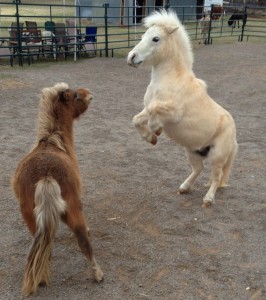
This is the trade-off, this is what makes the trail less traveled different.
The trail less traveled may involve a technique you come up with on-the-fly, that’s not in the handbook, something you have learned by watching your horse. This is wonderful, you are moving into intuitive learning, intuitive training, without steps. Sometimes we need steps like we need a map when we’re unsure of where we’re going, at the beginning.
But after awhile, the concepts become embodied and it is easier. Your convictions become stronger. The voices of the critical world fall away. You are moving along the trail, your horse picking her footing, dropping down off the mountain, heading into switchbacks with sunlight blinding you, skirting deadfall, down into that gorgeous valley where tall grasses tickle your mare’s knees and a thin snow-fed stream gurgles through. You are as one. And nobody can tell you any different.
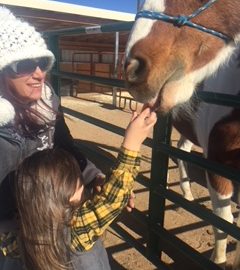
Once again, I address the thing I’m not all that good at: resolutions for the New Year. I try to make them easy and attainable, otherwise they go the way of crash diets and best laid plans that get forgotten the moment stress or a better offer sets in.
This Christmas we had the joy of having our wonderful family: son Cory, wife Amber and three-year-old grandson Avery visiting. Their visit brought many new insights to me, as it reminded me what it was like to be new parents . The care of new parents is so special and sweet, and all-consuming.
The other thing dear little Avery brought to me was the sheer joy of discovery. He got to feed and pet horses for the first time. If I’d had the video running I would’ve captured his squeals of delight and jumping up and down. I did catch this photo of Avery feeding Patches a carrot with his mom standing by.
So this brings to me to the first two Horse-olutions for you for the New Year:
Add a global view to your vision. If you find yourself getting really focused on one thing: a 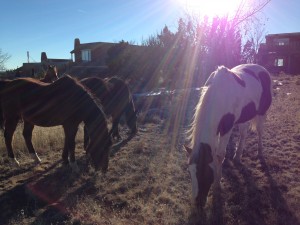 behavioral issue, a health issue, etc., take a step backward and see the bigger picture. In working at liberty and bodywork, many times I’ve experienced a horse who couldn’t stand the scrutiny of the person working with him. Either she was too close or her concern was too great. I ask her to take a step backward and the horse will turn his head to her and acknowledge her beautifully. Her recognition of his need for space was profound. This is a metaphor for life.
behavioral issue, a health issue, etc., take a step backward and see the bigger picture. In working at liberty and bodywork, many times I’ve experienced a horse who couldn’t stand the scrutiny of the person working with him. Either she was too close or her concern was too great. I ask her to take a step backward and the horse will turn his head to her and acknowledge her beautifully. Her recognition of his need for space was profound. This is a metaphor for life.
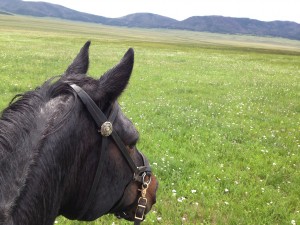 Continue the joy of discovery. A new trail, a new experience. Just yesterday my mare Jazzie decided she wanted to take a different trail home, and we bounded through the arroyo and up a hill to arch around some houses to home. The joy in her was so much fun. I was reminded of Avery with his squeals of delight at getting to pet the horses, and finding a special bond with one of them in particular. As a child my parents took me into the English countryside for picnics. The highlight of that trip was getting to pet a horse over a fence. Perhaps that was the start of the addiction for me.
Continue the joy of discovery. A new trail, a new experience. Just yesterday my mare Jazzie decided she wanted to take a different trail home, and we bounded through the arroyo and up a hill to arch around some houses to home. The joy in her was so much fun. I was reminded of Avery with his squeals of delight at getting to pet the horses, and finding a special bond with one of them in particular. As a child my parents took me into the English countryside for picnics. The highlight of that trip was getting to pet a horse over a fence. Perhaps that was the start of the addiction for me.
Maybe you’ll discover something new in one of your horses, or in your life. I wrote about this last year, but new never gets old!
Respect differences. Notice how you interact with different people. Horses do that too. They 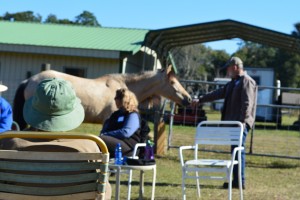 don’t respond to everyone the same way. Sometimes you are drawn to people and sometimes repelled by them. Sometimes you think you will be friends with someone but the friendship never quite happens. Horses are capable of great bonds with each other and people. Notice what they are and protect your horses from those they aren’t comfortable with, and fill their lives with positive relationships if you can.
don’t respond to everyone the same way. Sometimes you are drawn to people and sometimes repelled by them. Sometimes you think you will be friends with someone but the friendship never quite happens. Horses are capable of great bonds with each other and people. Notice what they are and protect your horses from those they aren’t comfortable with, and fill their lives with positive relationships if you can.
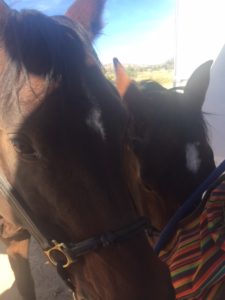
Work with energy. Energy is part of the previous horse-olution but is part of everything we do. Horses seek positive, grounding energy in humans. It’s not necessary to do anything, just be yourself. If you don’t know yourself well, the horse may know you better than you know yourself. If you’re anxious and your anxiety transfers to your horse, pay attention to that. Maybe change your agenda for the day or until you can become still inside.
Just know that every emotion you have, the horse experiences. They may not understand its complexity, but they feel it. The horse’s presence may be calming, but make sure your presence is not disruptive to the horse so he or she doesn’t absorb it and act on it. Don’t hide your emotions, but on the other hand, I think it’s best not to use your horse as a dumping ground for emotional baggage.
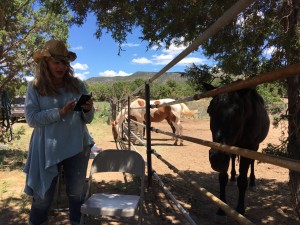
Talk to your horses and around your horses. This past week my granddaughter Ariana and I were working on some teaching videos with the horses. The sounds of our voices put them to sleep. Of course, that could mean we’re incredibly boring, but I tend to think it was soothing to them. I did some hands-on, and all the horses not receiving any work dozed off.
I’ve noticed that when I’m mucking, or brushing, if I talk to them, they become very relaxed. They like my noticing things about them, asking how they got this scratch or noticing where they are sore.
Work with other horses. It’s easy to think all horses do the same things, and there are some general things that all horses do. But when you get a chance to work with multiple horses, it broadens your view of the horse world.
When I meet horses, I want to take in their personalities. Who are they? What do they want to show me?
When I only worked with my own horses, I had a limited view of them. Since I see many horses, I can bring the knowledge I gain from others home to my horses and they benefit. That’s why the workshop setting is so valuable; we get to work with many horses and see differences and similarities.
We can also gain a more neutral perspective.
Remember gratitude. With all the wants entering into daily life, I remind myself to be grateful for what is. For family, the horses I have, the health I have, the work I’m entrusted to do. With each year, new opportunities arise and others fall away. To mourn the loss of beloved beings is natural, and takes time and a holding place. Gratitude has its place in honoring what was loved and what is still here to be loved. Spring will come and a new order can rebalance losses and gains in ways we never can predict.
Breathe. My mare Zuzka started teaching breathing exercises at workshops about two and
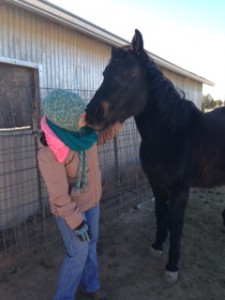
a half years ago. She wanted people to just stand and breathe with her. She wanted me to breathe with her. No touching, nothing else. While I was teaching a lesson, she decided she didn’t want to do the lesson, it was time to stop and breathe.
That was a more important lesson to me than what was on my agenda!
This way of breathing is a way of being together without doing. She may want to breathe on your face, or synchronize breath with you. While doing bodywork, often I will feel the horse breathe into a tight or sore spot. This is another way of using breath in a very constructive manner.
Yoga breathing exercises are great, yet I know no horse who has taken a yoga class – they know this on their own. Zuzka’s message is quite simple: stop doing and breathe.
The breathing is something I now do often – before I ride or do groundwork, or when I feel I’m not quite centered. Just taking that moment can make all the difference.
Happy New Year! My wish is for your new year to be full of joy and promise!
(c) Susan Smith, Horses at Liberty Foundation Training, Equine Body Balance (TM)
Please see my
Events for information on upcoming clinics and workshops.
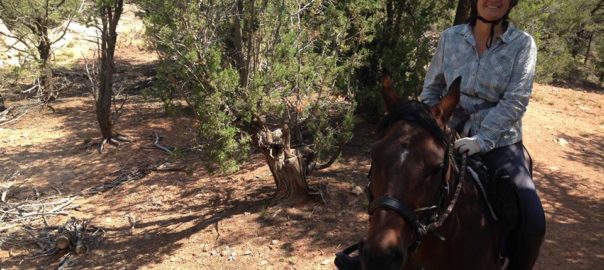
This question comes to me often: When can I ride my horse? How much can I ride my horse?
In our society, there is a strong push to get horses back to work after an injury or illness, just as there is with people. If you have a surgery, you can be back to work pretty quickly these days after some procedures. The problem with this is that the body may need longer to recover and may be playing catch-up.
At the same time, movement is essential to the health of the body. The horse may need a gradual curve of gentle techniques and movement exercise before actual work. Surgery interrupts the regular function of the body. Any injury or surgery affects the entire organism.
The liver controls tendons and ligaments, for example, so when t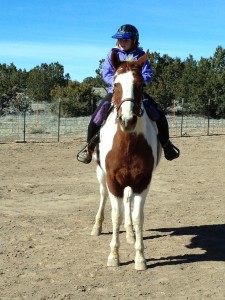 hose areas are affected, the liver is deficient in fluids and therefore the tendons and ligaments are also not getting vital fluids and don’t move as efficiently.
hose areas are affected, the liver is deficient in fluids and therefore the tendons and ligaments are also not getting vital fluids and don’t move as efficiently.
I use the example of a horse hitting its head really hard and getting stitches. Just because the vet has deemed him “fine” and patched him up, doesn’t mean he is ready to roll. The horse may exhibit strange behavior after the bump on the head, sometimes neurological symptoms such as wobbliness. Or sometimes symptoms take years to manifest.
I’ve often asked clients if their horse has had a head injury at any time, because of something I’ve seen happening (or not happening) in the body. “Oh, yes, ten years ago he hit his head on the trailer but it healed up just fine.”
As we know, our bodies hold a road map of everything that has happened in our lives, and horses’ too. Everything – physical, emotional, you name it, it’s in there. That’s why every injury or illness needs support from within, not just from without.
Usually the vet will have a timeline for when to begin hand-walking, or lunging your horse after an injury. The timelines after specific injuries, such as ligament and tendon injuries, falls, illness, etc. will help you understand how many weeks of one activity you may have and how long to engage in it. You will have to depend on your knowledge of your horse and how he is feeling to know whether the vet’s expectations meet what your observations bear out.
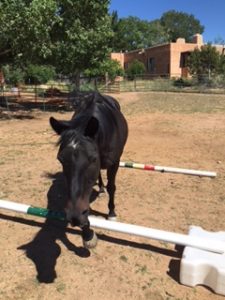 When I was endurance riding, our ride vets would remind us that we knew more about our horses than they did, in one way. We were around our horses all the time. We knew their habits, and we knew when they were doing fine and when they were not.
When I was endurance riding, our ride vets would remind us that we knew more about our horses than they did, in one way. We were around our horses all the time. We knew their habits, and we knew when they were doing fine and when they were not.
My gelding Khami was a funny example of that. He used to like to sleep flat out on the ground, while tied to the trailer, with his eyes wide open, when at an hour-long vet check. The local New Mexico ride vets knew this habit of his and didn’t worry. When we rode in Paonia, Colorado once, he did this and the vet was frantic. He said I must get my horse up, he was worried and couldn’t find any vital signs. Khami got up to see what all the commotion was about, but he was very well rested. His vital signs were fine and he went on to finish a 2-day 100.
The question of when to ride your horse is going to vary with some horses a great deal. It depends on whether they are fit to be ridden, and for how long they can be ridden. It depends on their age, and their temperament and training. The saddle and bridle. The person who is riding them. The owner may have to modify his/her expectations of what the horse can accomplish for awhile.
I look at a lot of factors:
Since I have a roller coaster experience with one of my horses — sometimes he’s sound and sometimes he’s not — I’m really tuned into this question. People may say, well, he’ll warm out of it. Maybe yes, maybe no. I want to understand the problem and help him with it, before I ask more of him. I want to ride in such a way, if I’m riding, so that the horse does not become more stiff afterwards. The exercise, whether riding or ground, needs to support and heal rather than set him back.
And when I do ride him, I ride him gently, and therapeutically, going over cavalettis, gentle trots, sometimes on uneven terrain, exercises designed to strengthen his muscles, tendons and ligaments. I must check in with my own body and do a Mounted Body Balance session on myself to make sure my body is not restricting him in any way. I try to focus on the things that feel so good about riding him – he’s so peaceful to ride, I love the way my legs drape down his sides. I love that I can sit his trot, he feels like an ocean liner. I continue to ride and mix it up, doing some Equine Body Balance on him before or after each ride, or in between, which supports the exercise we’re doing.
With the horse who may not want to lift a hind leg but is otherwise sound, yes, you can generally ride the horse, but we need to continue to work on why it’s hard for her to lift that leg. With the horse who can’t disengage behind, there is something more complicated going on that needs to be addressed. Some suppling exercises added to the program of bodywork will help with that in a lot of cases. You can possibly ride that horse in a straight line but not do any lateral work. I may need to look at how the rider’s position may be impinging on the horse’s movement. We may add some gentle suppling ground exercises to increase lateral flexibility. If the horse is having trouble raising a foreleg or striding forward, I want to flex the forelimb to find out where restriction is without causing pain. Sometimes the problem is at the far end of the horse from what appears obvious.
While the body is complicated, with its elegant and efficient network of nerves, blood, bones, lymph, muscles, nerves, tissues, organs, etc., it is possible to support the health in the horse with non-force techniques specific to certain conditions. When we are mounted, we can increase our knowledge of how our bodies affect our horses and how they might also help us so we can be more comfortable and efficient in the saddle. This work plus self-care can do wonders for horses and their owners, making it easier to develop a treatment/ rehab program that best suits their needs.
(c) Susan Smith, Horses at Liberty Foundation Training, Equine Body Balance (TM)
Related link: What? No more riding?
Please see my
Events for information on upcoming clinics and workshops.
I was lying on the massage table receiving physical therapy recently and talking about myself as I was asked to do, past injuries, etc., and then I made a switch to talking about one of my horses. My therapist expertly swung me back to the discussion of “me,” which is why I’m there, and I realized something – not just about me, but many of us who work with horses or love them.
We would prefer to talk about horses than anything else. Horses are like meditation to us.
They are definitely calming, even when talking about something that isn’t right with them.
But there is another piece to this which may sound wild to some people, but I’ll put it out there: we get lost in the horse. It becomes an “out-of-body-experience” when we need to be in our bodies to experience it. We need to be in our bodies to give the horse her due, and to heal ourselves.
This is the awareness, the eye-opener, that appeared to me on that table, that I want to share with you, because I am so good at doing this myself.
I know I’m talking about several different things, but I’m really talking about the same thing. I’m talking about staying in the moment, in the body. If I am to learn the new way of using my body in physical therapy, then I need to be in the moment to absorb all the nuances of what my practitioner is telling me. It’s not a time to wax eloquent on how far one of my horses has come in his physical or emotional development!
While sometimes the conversation can be helpful for bringing us around to the true story of one’s own body, it can also take us far afield, out of ourselves and pain.
I’m in physical therapy for a reason, because I’m healing from something. Pay attention.
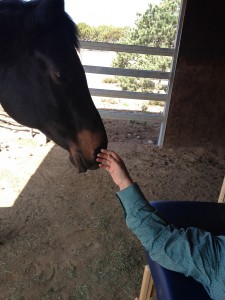 Being “in the moment,“ and “in the body” do take some time and energy to achieve, especially in Western society. We are expected to be out of the body in a lot of our daily interactions with people and in our jobs.
Being “in the moment,“ and “in the body” do take some time and energy to achieve, especially in Western society. We are expected to be out of the body in a lot of our daily interactions with people and in our jobs.
But horses live in the body and in the moment, so they would like our interactions with them to take place there.
I will say that with every horse mishap and accident I’ve had, I’ve been out of my body. My energy has not been centered. People who come to me after horse wrecks tell me all the time, “I knew that I shouldn’t have gotten on…” “I knew the horse wasn’t ready…” because it can be the horse that is not agreeable also, not just the person.
What has helped me to stay in my body has been a variety of things. There will always be things to pull me off course. But these steps help me stay focused:
When I work with horses in a healing capacity, if they are trying to avoid my noticing something painful, they will flatten their ears or kick out maybe, or become dull in the eyes. They may move away from me and give me the distinct impression I’m not welcome. Sometimes the mere intention of wanting to heal will make them nervous. I have to arrive in their space with less agenda and give them space. The space may be then filled with part avoidance, but will gradually turn to curiosity as I work in areas that are not so triggered for them.
With the horse, while their natural state is to be in the body all the time, when people are around and trying to help with pain, sometimes they get “out of the body” too, just like us.
![[Catherine Sobredo Photography]](https://susansmithsantafe.com/wp-content/uploads/2012/08/imgp2369-edit-199x300.jpg)
Sometimes we know we need help with something, but we are operating with our foot on the brakes and accelerator at the same time because of pain, whether physical or emotional.
Deflecting attention away from the pain can also be a way of not being in the body or the moment.
The horse also knows that we know how to figure out a lot of things. This is one of the things they like about us, and attracts them to us. We may not be as smart as them in some ways such as staying in the moment for such long stretches of time, but we can get aha moments and figure out how to help them because we have the intellect.
What has helped me a lot with the “lost in the horse” issue is to work on something that is my challenge and include one of my horses. For example, the PT work has offered me new ways to walk and sit. I’m applying that new knowledge to my walking with my horse, and my sitting in the saddle. This can best be done with a horse with whom you have a good relationship with, not recommended with one you’re trying out for the first time!
I find my horse – whichever one either comes forward for the task or I feel is the one for that activity – enjoys being helpful and helping me figure it out. The horse will behave much the same way with this helping activity as they do when you introduce new activities for them. The added plus is that they can not only feel a sense of accomplishment from completing the activity, as they do with ones planned for them. But they can feel a sense of accomplishment in helping you solve a problem.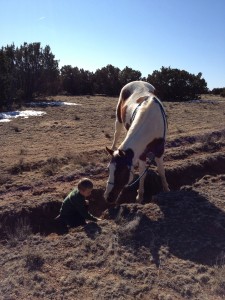
All of this helps me stay in the moment. It also gives me something new to talk about when I go to PT and can talk about the progress I have made, still weaving in my horse stories, but now in relationship to the PT work!
(Some of these new insights will be incorporated into this year’s Conformation, Compensation or Both? classes offered in Florida, Santa Fe and Oregon. The relationship work will be detailed in the class Equine Liberty from the Heart, offered in Santa Fe, NM)
(c) Susan Smith, Horses at Liberty Foundation Training, Equine Body Balance (TM)
Please see my
Events for information on upcoming clinics and workshops.

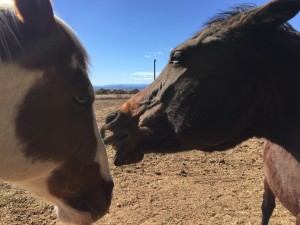 In horse training, leadership is discussed a lot. If the person doesn’t have leadership, the horse will not be as responsive to them. There are people who are born with innate leadership. In horses, leadership potential can be recognized the moment the foal drops to the earth.
In horse training, leadership is discussed a lot. If the person doesn’t have leadership, the horse will not be as responsive to them. There are people who are born with innate leadership. In horses, leadership potential can be recognized the moment the foal drops to the earth.
A breeder friend of mine once said, of certain foals, they recognized it in themselves and you as a person could immediately recognize this presence, this ability to be a leader. It wasn’t necessarily attached to physical attraction or size. It generally has to do with the presence of the individual and their awareness and caretaking ability, of other members of the herd.
Continue reading Leadership revisited – both horse and human
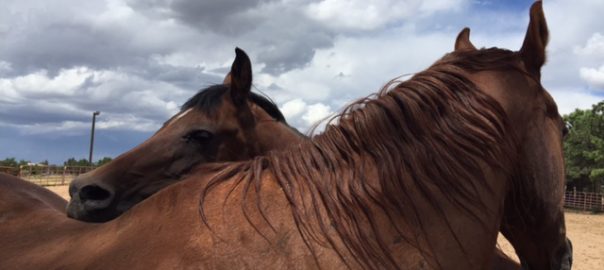
I am not one to make a lot of New Year’s resolutions, because I don’t want to get upset with myself for not keeping them. So my “horse-olutions” are ones that can be easily be accomplished and kept in mind during the year.
Personally, this year, my holiday was wonderful in that our two older grandsons came to visit. What was not so great was that throughout their visit I had very painful sciatica. While I work with people and horses on painful physical conditions, it’s another thing when it’s happening to me and others need to make room for my disability in their life.
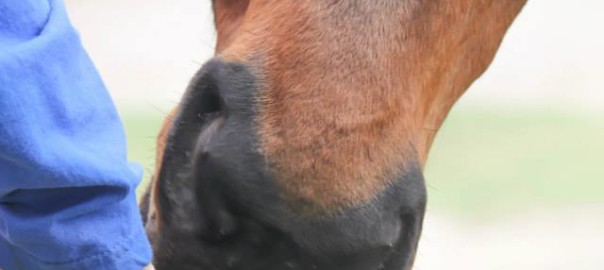
One reason I like to teach Liberty Foundations is because it offers a true reading of the horse, but it also gives a true reading of the person working with the horse.
When people work with the horses that come to the clinics, they are often working with horses who don’t know the Liberty Foundations at all, and start from scratch. We begin with some dimensional exercises, to be sure we are not carrying unwanted baggage into the workspace with the horse, that may influence how she is responding. This also shows what we need to do to adjust our energy.
Once we are with the horse, we can see what further adjustments need to be made with energy.
I start the horse, then the owner or attendee will work with the horse, and start building the foundations, and in turn, the relationship. What is beautiful is that we work toward the horse being able to transfer her knowledge of one relationship to the next student, and refine that knowledge and connection with each student.
Often people work with horses who are not their own, and this is sometimes freeing in terms of not dealing with an ongoing relationship. It allows students to also experience a number of different horse personalities and energies.
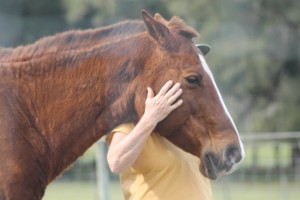
If the person has brought their own horse, sometimes the person’s relationship with their own horse is one where the horse takes advantage of some aspect of the person. Or the person is so accustomed to their own horse, that they don’t correct their horse with any show of leadership. Or their energy is too strong for that particular horse.
There is what I call a “tipping point,” where the owner or handler can become uncentered in trying to get their horse to do something. Once they are uncentered, their influence over the horse diminishes. I have had this happen to me, and it’s important to recognize it as it comes out of our desire to effect a change. It also comes out of our desire to have the horse love us and want what we want.
Consider asking these questions:
1. Does your horse step into your space when you are working with her?
2. Does your horse ignore you a large amount of the time?
3. Is your horse agreeable but seems to have no real life in her for the work you’re doing together, or tries to hurry through it?
4. Do you feel yourself tumbling toward your horse, in your eagerness to have her like you and do things with you?
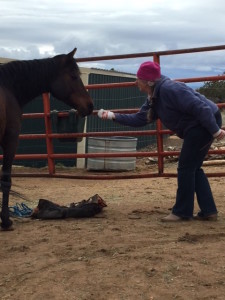 One of the important things about Liberty Foundations is there is essentially no agenda. The steps are sitting with the horse, greeting the horse, moving with the horse, in ways that are common and familiar to the horse. If the horse chooses not to engage, it’s not a big deal.
One of the important things about Liberty Foundations is there is essentially no agenda. The steps are sitting with the horse, greeting the horse, moving with the horse, in ways that are common and familiar to the horse. If the horse chooses not to engage, it’s not a big deal.
If the horse continually chooses not to engage, then we aren’t being engaging enough! We can read the intention of the horse and read our own intentions. What do we want? What do we want the horse to do? He refuses to connect!
We are looking for willing participation. In other forms of horsemanship, people can have great results with a lot of horses, but the horses are not always willing participants.
The way we work in Liberty Foundations is in a larger space, a small arena, with corners or even a paddock, where the horse has the freedom to leave any time he or she wants.
Through our sitting with and greeting the horse, the horse learns to accept our presence in the herd. Through our walking behind her, she learns that we can have the same influence as other horses, and can come into rhythm with her. Changing that up to walk beside her, and we are companions, taking a stroll together, looking at the horizon, grazing, spending time like a horse. Moving the horse away and inviting her back, she learns that the relationship has a flow, that some space is necessary in the relationship, but that we will come back to each other with a stronger bond.
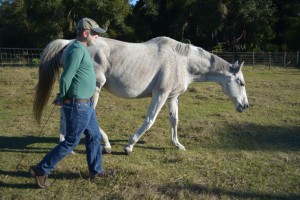
Out of this quiet, focused effort, our horses will want to engage. Their interest in activities we introduce will increase. We’ll learn what their preferences are and be able to make modifications and bring joy. Other training methods will grow organically from these Liberty Foundations as we continue to move along the pathway to introducing what we need in our training programs.
I have included some videos of the work, with myself and students, with horses who are both ridable and not, with horses who have had a lot of Liberty Foundations and those who have had none.
We are seeking a change, a shift in relationship, by allowing it to emerge. We want eyes, ears, gestures, to all point to a soft, willing horse, not one who is just going through the motions.
To get this, we need to be specific in our directions, and not be tipped over into wanting certain responses, seeking love or understanding, seeking a bond that will come if the person just stays centered, breathing, in the moment.
It’s important for the person to increase the amount of time they can stay in the moment, which will naturally increase as they practice this work. The horse always lives in the moment, so she can guide us on this journey.
If you’ve answered “yes,” to any of the questions posed above, see if you can change that around as you work with Liberty Foundations.
Videos:
The Shaping of a Liberty Horse
Prairie Flower with Jazzmine and Lorrin
Transitioning to Riding from Liberty Foundations Groundwork, September 2013 Clinic
(c) Susan Smith, Horses at Liberty Foundation Training, Equine Body Balance (TM)
Please see my
Events for information on upcoming clinics and workshops.
